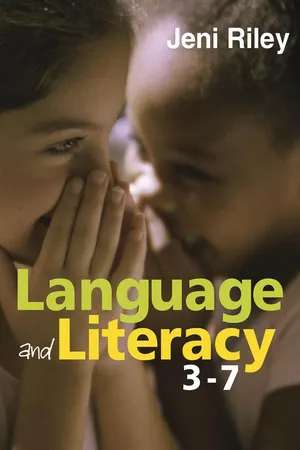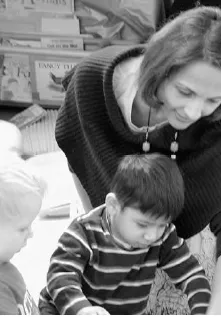![]()
Chapter 1
Learning to Communicate and to Think
Language is the most powerful tool in the development of any human being. It is undeniably the greatest asset we possess. A good grasp of language is synonymous with a sound ability to think. In other words language and thought are inseparable.
(Vygotsky, 1986:120)
The pattern is familiar: cries evolve to babbles, babbles are shaped into words, and words are joined into sentences. This sequence describes the path taken by all children as the language they hear around them is examined, internalized, and eventually developed into native-speaker competence.
(Bialystok, 2001:21)
Introduction
For the most part, we take our own language powers for granted. We treat the ability to speak, to listen and understand, to read and write as instinctive. Yet we use language in increasingly complex ways. We employ new technologies to communicate more variously and flexibly. New words find their way into our vast vocabularies in order to express fresh and subtle nuances as situations demand. But amid this complexity and change, we all appreciate that the purpose of the phenomenon of language is, put at its most crude, the human race needs to communicate to survive.
Early communication
There cannot be an adult anywhere who has been around babies and infants and who is not amazed by their capacity to communicate without misunderstanding and ambiguity. This command of communication develops seemingly with ease for the vast majority of children. At 10 months, babies point to a beaker of juice with tension in gesture and cry, leaving adults in no doubt of their desires. Toddlers hold up their arms and refuse to take a single step, ensuring a lift to car or buggy. Only a few months later, the child is able to communicate needs and concerns through body language and intonation, which is followed by single words and action, then by speech alone. Chomsky (1957) referred to language being a window on the mind and that by studying the way that children become users of spoken language we are provided with an insight into the way that the minds of these young learners work. We can observe how they order words into sentences, how they over-generalize grammatical rules and then dismantle their own hypotheses in order to use the correct forms. Not only are we offered a glimpse of the formidable intellectual mechanism that is at work, but we become aware of the interests of the child as it impacts on her growing understanding of the world. A language system is being constructed with an ability to reason and to think alongside it. While recent research shows there is a wide variability in both the rate and achievement for children learning language (Fenson et al., 1994) the process has an indisputable consistency.
The stages of language development
Children are propelled into the ability to speak through the twin processes of their own drive to communicate and the desire of adults to enable the child to occupy a full place in their world of shared meanings. It would appear, that adults are motivated to talk to babies but, similarly, the infants are programmed to respond with their own communicative skills and, according to Chomsky (1957), they possess an innate ability to process the language they hear around them.
Communication begins with the building of a relationship between a mother (and it is most frequently the mother) and her newborn infant from the first few hours of life, and this bonding stems from and signifies mutual enjoyment of one another. The establishment of this relationship is shown when babies as young as 1 week old prefer to gaze at a human face, rather than other objects, however interesting, patterned or mobile (Trevarthen, 1975, cited in Harris, 1992). Researchers are in agreement that babies at 5 or 6 weeks old are able to engage in mutually satisfying and conversational-type activities. This prototype of conversation is demonstrated by a variety of turn-taking activities, such as mouth-opening, tongue-poking, eye gazing and vocalizing, all of which occur, most commonly, at care-giving and changing times. These behaviours soon become ritualized. These activities are crucial as precursors to speech as they reinforce the supportive roles that speaker and listener need to adopt in order to maintain communication. Also, as Whitehead suggests, these activities are ‘something to do with the complex business of getting two minds in contact, because the exchange of meanings and language is at the centre of human communication’ (1997: 4).
The interactive behaviours become more elaborate and prolonged, the smiling, cooing, chuckling and pointing develop into games of peekaboo, throwing and retrieving of objects, and hide, find and show. Playful actions and sounds, often repeated, maintain pleasurable response and prepare the way for a genuine conversation.
Early speech – the first word
The articulation of the first word is not a clear-cut event. The sounds made by the infant initially are playful and random; also the baby’s phonological (sound-making) production mechanism is immature. This makes word identification difficult. Whitehead suggests that for an utterance to be considered a ‘word’ it needs to be:
- produced and used spontaneously by the child;
- identified by the caregiver who is the authority on what the child says (Nelson, 1973); and that
- it occurs more than once in the same context or activity (Harris, 1992). (Cited by Whitehead, 1997: 5)
The first word is considered to be a developmental milestone and with some babies can be detected as early as 9 months old (Halliday, 1975), but it is likely to be observed around the first birthday. The initial utterance offers an insight into the child and her life situation. The name of a pet, a food, a drink, a comfort blanket or toy reflect the main preoccupations of these young minds, sometimes, even before the time-honoured ‘Mum-mum-aa’ and ‘Dad-dadaaa’. The richness of the meaning embedded in single-word utterances is described as a semantic field by linguists, and is specific to both context and each individual child.
Case Study 1 . 1
My own daughter at 15 months, when living on a military base, cried ‘Dadaaa’ to every blushing teenage cadet in uniform she glimpsed from her pram. Her response (and one that is classified by psychologists as ‘over-extension’!) to all males in uniform was habitual and of abiding fascination. Another 14-month-old child has the sole working vocabulary of ‘I’m gorgeous!’ and ‘tractor’. The phrase he repeats parrot-fashion to attract the amusement of adults but the noun denotes a current obsession. ‘No’ and (rather less usefully to the child!) ‘Yes’ are the early words that are understood universally and carry unambiguous meaning.
Learning and Teaching Suggestions
Learning to speak develops initially from the need to express a deeply personal concern or preoccupation. Compare your recollections with a colleague. What is your experience of children learning to speak? Can you recall their first words? What categories did these words come in?
The 'two-word' stage
Children experiment with speech as they approach 2 years of age and in so doing they become more inventive and adventurous in the use of language. Combinations of words are attempted and, if they are rewarded by the intended results, the structures are used again and again, and perfected. The two-word stage relies on intonation to achieve full linguistic clarity, so for example, ‘Daddy house’ can mean ‘This is Daddy’s house’ or ‘Daddy is in the house’ but said with a rising intonation might mean ‘Is Daddy in the house?’
Case Study 1 . 2
My grandson, Benjamin, at 19 months demanded ‘Choclate! fetch it! – shall us?’ The first three words were spoken with firm, clear expectation and then the softer, wheedling ‘shall us?’ applied persuasive pressure. The ability to exert authority is not curtailed by a limited command of speech structures; at this age, determination and shrewd judgement of people wins over linguistic expertise. A few months after the incident above, during an exhausting (for me!) afternoon baby-sitting, Benjamin, now about 2 years old, noticed his father’s juggling balls (forbidden to him!) safely stored on a high shelf. ‘I juggle now,’ he stated with a firm resolve. Demonstrating a clear case of premature senility, I reached down the box of balls. The ensuing damage caused by balls hurled enthusiastically into the air got us both into a great deal of trouble!
This stage of language development, involving the combination of two or three words, is governed by the rules of grammar. The ability to combine words in this way in order to express meaning denotes an appreciation of syntactical structure that has intrigued and excited linguists for years. The rules that children generate for themselves may not be conventional, nor are they those that they have heard used by anyone previously, but there is an applied logic and a system and the product is, indisputably, functional.
Developing speech
Through the pre-school years children are exposed to many languageenriching experiences. Spoken language is developed through being surrounded by conversations, through the multiple interactions that occur with different people, through watching and listening to television and videos, through chanting rhymes and poems. Alongside this, children experience the speech-enhancing effect of written language. Children are exposed to and are encouraged to interact with books, through hearing stories, looking at and talking about the illustrations, enjoying magazines, using video box labels, receiving birthday greetings and postcards. They observe adults e-mailing and text messaging, writing notes, shopping lists and letters.
By the age of 4 most children have acquired at least 1,600 words and can understand many more (Crystal, 1987). The physiological mechanisms of the use of mouth, tongue, lips and hard palate to produce speech are now well developed and enunciation is more intelligible and clearer. The powerful intellectual capacity to exploit the rules of language that have been worked out on their own, not merely to repeat language, is demonstrated by children’s over-generalization of past tenses as in ‘goed’ and ‘see-ed’, the logical regularization of plurals wi...

